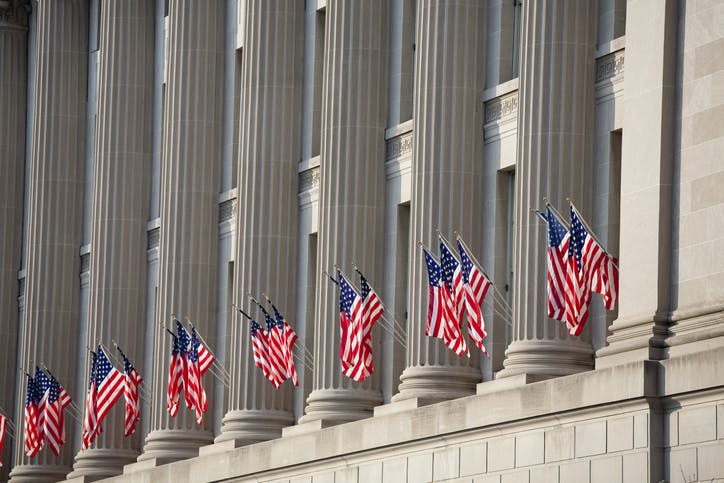Ike, Nixon, Reagan, Bush I, and Bush II —They Fought the Bureaucracy and the Bureaucracy Won
If Republicans win this fall, the struggle will only deepen and grow more bitter.

Conservatives have repeatedly tried to change the unelected bureaucracy in Washington. Presidents Eisenhower, Nixon, Ford, Reagan, George H.W. Bush, and George W. Bush made a variety of efforts to reshape the bureaucracy.
There were big fights. In virtually every instance, the bureaucracy won. President Trump aggressively fought to change things. As a candidate and president, he immediately found himself under siege. Key elements of the permanent, unelected bureaucracy bent and broke the law attempting to destroy him.
The same war against Mr. Trump continues with the Justice Department, various Democratic district attorneys, and the New York State Attorney General all attacking the Republican presidential nominee.
If Republicans win this fall — even if they sweep the presidency, the Senate, and the House — the struggle will only deepen and grow more bitter. The federal bureaucracies, lobbyists, press allies, activist organizations, and congressional supporters are not going to quietly accept the American peoples’ verdict.
Left-wing groups at Georgetown University and elsewhere are already planning a campaign of continuous resistance in case Mr. Trump should win.
Scott Rasmussen recently found what he called the most frightening number in his 35 years of looking at public opinion. He identified a group of voters he dubbed “the elite 1 percent.” These people are mostly liberals from dense urban areas. They have post graduate degrees and make more than $150,000 per year.
When he asked this group if its members would cheat to win an election, 35 percent said they would. Among a subset of the group who are “politically obsessed” a stunning 69 percent said they would cheat. For perspective, only 7 percent of the larger sample said they would rather cheat than lose an election.
Mr. Rasmussen’s elite 1 percent are exactly the persons who will do virtually anything to stop the Trump coalition from fundamentally changing the leftwing bureaucracy. After all, it’s their bureaucracy, and they have spent 90 years building it.
In 1952, President Truman captured the power of the bureaucracy to block and undermine even the president of the United States. When General Eisenhower was elected, Mr. Truman said, “He’ll sit here and he’ll say, ‘Do this! Do that!’ And nothing will happen. Poor Ike — it won’t be a bit like the Army.”
That was 72 years ago. The federal bureaucracy has grown stronger, more ideological, more dictatorial, and more difficult to control or change. To defeat the entrenched bureaucracy, conservatives must replace the leftwing bureaucrats with new people willing to do what the American people want.
President Lincoln is the model. He took control of government and forced it to be responsive to the leaders the American people elected. Mr. Lincoln dismissed and replaced 1,195 of the 1,520 executive branch positions.
As Princeton University Professor and renowned Lincoln scholar Allen Guelzo wrote:
“In the State Department, Lincoln not only replaced the secretary and assistant secretary, but the disbursing clerk and all five territorial governors; in the Treasury Department, he appointed not only a new secretary and assistant secretary, but the 1st comptroller, treasurer, register, solicitor, chief of the Bureau of Construction, and the director, treasurer and chief coiner of the U.S. Mint.”
Under Lincoln, Mr. Guelzo adds, “the Interior Department also got a new secretary and assistant secretary, and also a new chief clerk, new administrators of the General Land Office, the Indian Office, and the Pension Office, the superintendent of the Census and commissioner of public buildings.”
Mr. Lincoln acted decisively because the bureaucracy he inherited was filled with southerners who favored secession and with Northern Democrats who deeply opposed the Republican Party.
If Mr. Lincoln allowed his opponents to remain in charge of the federal government, it would have been impossible to win the Civil War. He acted with the same kind of firmness and courage on the bureaucratic battlefield that young Americans exhibited on the military battlefields to preserve the Union and end slavery.
There were only 5,837 federal employees in 1861 (excluding the 30,000 postal workers who represented the largest arm of government before the Civil War). So, Mr. Lincoln replaced 41 percent of the civilian employment of the federal government.
Today, there are approximately 1.4 million civilian federal employees outside the Department of Defense. A Lincoln-sized reduction would amount to more than 585,000 people. Obviously, no new administration can force through change on such a gigantic scale.
However, a replacement at the rate of only 10 percent of Mr. Lincoln’s first-year effort would still exceed 58,000 bureaucrats. This is probably the smallest change that would begin to return control of the government to the American people.
If conservatives are serious about returning to government of, by, and for the people, this is the scale of change for which they must begin planning.

